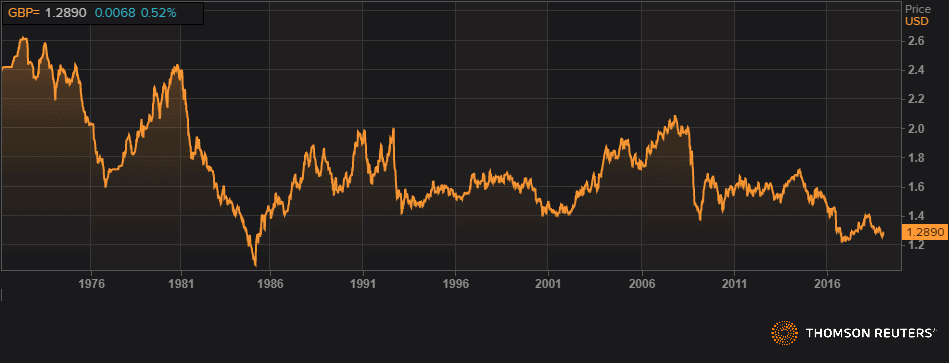Sterling seems to have been in the middle of a storm for some years now. It has depreciated to such an extent that for a lot of investors, the currency exchange rate has been the single biggest contributor to investment returns over the past five years.
But where to now? The pound might be at its lowest level against the US dollar since 1985, but there’s nothing to say it can’t go any lower. On the other hand, a lot of bad news is already baked into its value, and any hint of a good Brexit – or no Brexit at all – will lift its spirits.
We think it’s wise not to try to predict where sterling will be in twelve months’ time. As Neil Armstrong once said, “We predict too much for the next year and yet far too little for the next 10”.
The runway lights aren’t very bright
It was in 2012 that the word Brexit was first coined. For a while, it had competition from Brixit and a rather cumbersome ‘UKexit’. It’s not surprising that Brexit won through, but it is a little surprising that it wasn’t until December 2016 that the word found its way into the Oxford English Dictionary – six months after the Referendum vote.
Depending on your disposition, it has been somewhere between an absorbing political debate, and a dull and repetitive exercise, not dissimilar to knocking your head against a brick wall.
By the time you read this, things will have undoubtedly changed significantly as we head towards the exit. But at the moment, the runway lights aren’t very bright, and that could even mean that the landing has to be aborted. If we do land at the first attempt, it looks like it could be bumpy and it’s sure to take us a long time to taxi to the terminal building.
But what does all that mean for our pension pots? Well firstly, and potentially most importantly, there’s the impact on the value of sterling. Currency risk over the past five years or so has turned out to be one of the biggest headaches for asset managers, as the value of Sterling in particular has fallen significantly against other currencies. Where to next is to a large degree dependent not just on the shape of Brexit, but how it is interpreted by the markets.
In the middle of July 2014, £1 was worth around US$1.72. At the time of writing this, it is worth US$1.29. In other words, if you owned £100 worth of shares in a US company in 2014, then without any change in the share price and without any dividends, your shares would now be worth £133.
If you look at the chart below, you will see that back in 1972 £1 was worth over US$2.60. If you owned £100 worth of the same shares in 1972, they would now be worth over £200.

Currency markets, like all financial markets, hate uncertainty. But it seems that at the moment, the only certainty they have is uncertainty; for a while at least.
What way sterling? We don’t know, nobody knows. That’s why at NOW: Pensions, we have a currency hedge on all our overseas assets so that whatever happens, the impact of violent fluctuations on the foreign exchange markets will be minimalised for our members.
While we’re on the subject of Brexit, you probably know that NOW: Pensions Investment, the fund manager for our pension fund assets, is based in Denmark and manages our funds through the EU passporting regime. We have assessed the impact should we have a cliff-edge Brexit on 29 March, and we can confirm that NPI will be able to continue managing the funds through a temporary passporting regime which is being put in place by the Financial Conduct Authority. So at least that’s one less thing to worry about.
Rob Booth, Director of Investment and Product Development





